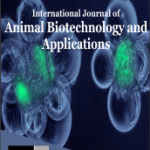Open Access

Anas Ansari

Divya Kundan

Harsh Mishra
- Students, Department of Pharmacy, Meerut Institute of Engineering and Technology, Meerut, Uttar Pradesh, India
- Students, Department of Pharmacy, Meerut Institute of Engineering and Technology, Meerut, Uttar Pradesh, India
- Students, Department of Pharmacy, Meerut Institute of Engineering and Technology, Meerut, Uttar Pradesh, India
Abstract
The gastrointestinal tract’s (GIT) functionality and health are essential elements that influence animal productivity. Since the management of GIT growth and health involves numerous complicated systems, it is critical to have a better understanding of these interconnections in order to create strategies for modulating GIT functioning and health in the perspective of better animal performance. Within in the animal scientific community, this term of “gut health” has sparked considerable interest. Furthermore, there is no precise definition of gut health and functionality, or how to quantify it. A novel approach to gastrointestinal function and discuss how good gastrointestinal functionality can help animals perform much better and live longer. Diet, effective construction and function of such gastrointestinal membrane, host interactions with the gastrointestinal microbiota, successful absorption of nutrients of feed, and efficient immunological state are the essential components of gastrointestinal functionality addressed in this article. Whereas the connections between such domains are intricate, a number of different approaches are required to establish dietary strategies that will help farm animals become more adaptable to the endogenous and environmental difficulties they will face throughout their productive lives. The objective of this section is to display animal as well as veterinary scientists but also nutritionists with a modern classification of gastrointestinal functionality which can be used to establish a multiple disciplines approach for improving animal health, welfare, and effectiveness even as world’s population continues to increase.
Keywords: Gastrointestinal, Microbiota, Nutrition, Immune system, Functionality, Health, Welfare
[This article belongs to International Journal of Animal Biotechnology and Applications(ijaba)]

Browse Figures
References
1. Peloquin JM, Nguyen DD. The microbiota and inflammatory bowel disease: Insights from animal models. Anaerobe. 2013; 24: 102–106. 122.
2. Lee W-J, Hase K. Gut microbiota-generated metabolites in animal health and disease. Nat Chem Biol. 2014; 10 (6): 416–424.
3. Atkinson MA, Chervonsky A. Does the gut microbiota have a role in type 1 diabetes? Early evidence from humans and animal models of the disease. Diabetologia. 2012; 55 (11): 2868–2877.
4. Tlaskalova-Hogenova H, Stepankova R, Kozakova H, et al. The role of gut microbiota (commensal bacteria) and the mucosal barrier in the pathogenesis of inflammatory and autoimmune diseases and cancer: Contribution of germ-free and gnotobiotic animal models of
human diseases. Cell Mol Immunol. 2011; 8 (2): 110–120.
5. Muegge BD, Kuczynski J, Knights D, et al. Diet drives convergence in gut microbiome functions across mammalian phylogeny and within humans. Science. 2011; 332 (6032): 970–974.
6. O’Sulliyan A, He X, McNiven EMS, et al. Early diet impacts infant rhesus gut microbiome, immunity, and metabolism. J Proteome Res. 2013; 12 (6): 2833–2845.
7. Hooda S, Boler BMV, Kerr KR, et al. The gut microbiome of kittens is affected by dietary protein: Carbohydrate ratio and associated with blood metabolite and hormone concentrations. Br J Nutr. 2013; 109 (9): 1637–1646.
8. Pankoke H, Bowers MD, Dobler S. Influence of iridoid glycoside containing host plants on midgut beta-glucosidase activity in a polyphagous caterpillar, Spilosoma virginica Fabricius (Arctiidae) J Insect Physiol. 2010; 56: 1907–1912.
9. Pauchet Y, Wilkinson P, Chauhan R, Ffrench-Constant RH. Diversity of beetle genes encoding
novel plant cell wall degrading enzymes. PLoS One. 2010; 5: e15635.
10. Regel R, Matioli SR, Terra WR. Molecular adaptation of Drosophila melanogaster lysozymes to adigestive function. Insect Biochem Mol Biol. 1998; 28: 309–319.
11. Ribble D, Smith M. Relative intestine length and feeding ecology of freshwater fishes. Growth.1983; 47: 292–300.
12. Robinson CJ, Schloss P, Ramos Y, Raffa K, Handelsman J. Robustness of the bacterial community in the cabbage white butterfly larval midgut. Microb Ecol. 2010; 59: 199–211.
13. Santo Domingo JW, Kaufman MG, Klug MJ, Holben WE, Harris D, Tiedge JM. Influence of diet on the structure and function of the bacterial hindgut community of crickets. Mol Ecol. 1998; 7: 761–767.
14. Schondube JE, Martinez del Rio C. Sugar and protein digestion in flowerpiercers and hummingbirds: A comparative test of adaptive convergence. J Comp Physiol B. 2004; 174: 263–273.

International Journal of Animal Biotechnology and Applications
| Volume | 8 |
| Issue | 1 |
| Received | June 11, 2022 |
| Accepted | May 3, 2022 |
| Published | January 7, 2023 |


